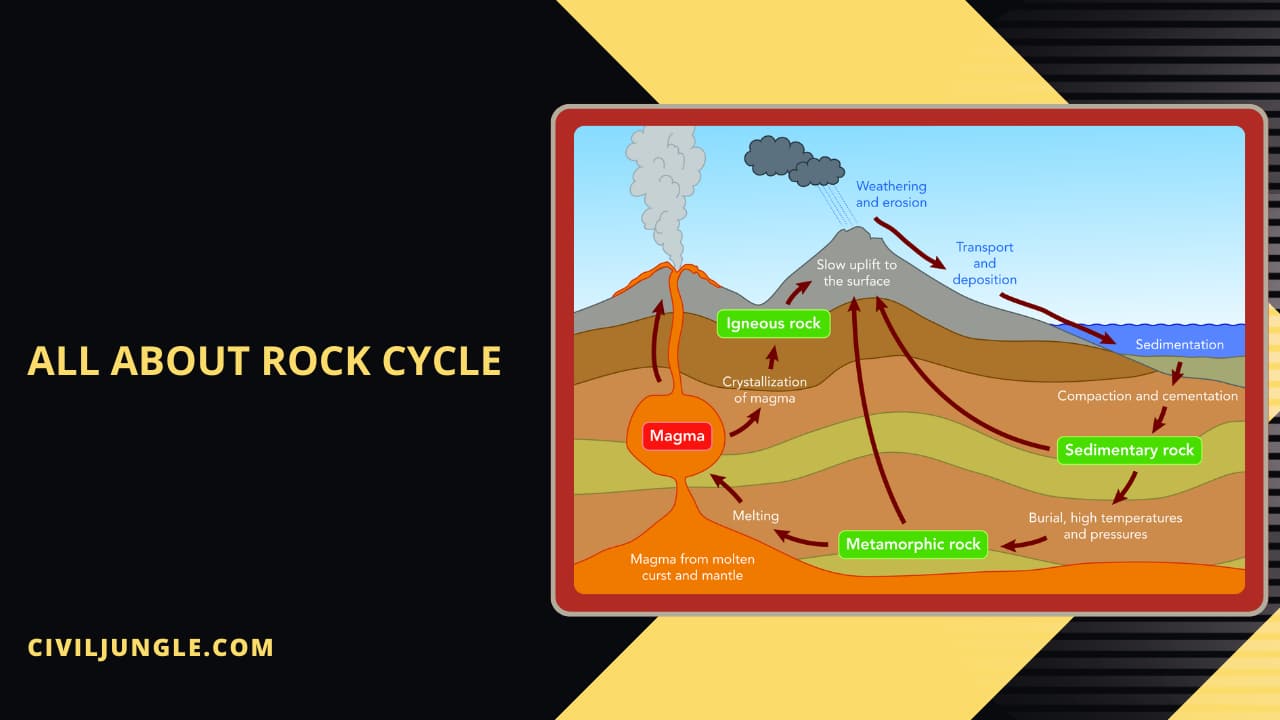
Introduction of Rock Cycle Steps
Rocks are one of the most common materials found on Earth. The Earth is made up of Rocks. The rocks are composed of different types of mineral grains which is combined in different ways and possess various properties.
Rock is a natural rigid substance which is found on the earth. Rocks are widely used in the construction of building and highway. If you see the buildings which were constructed in the olden days, then you will be observed that all the structures are constructed with the rocks.
The structures which are constructed with their pop rocks are very durable as compared to the construction of the structures by bricks. In this article, you will get to know all about the rocks and the stages of the rock cycle.
What Is Rock Cycle?

Rock cycle is the natural process in which rock changes one form to another. There are many changes which are happening in the rock at a very slow rate. The Rock Cycle is a model which is developed by the geologists to explain the relationship between sedimentary, igneous and metamorphic rocks.
The Rock cycle is a process in which a group of changes take place. Igneous rock can change into the sedimentary rock or the Metamorphic rock. Sedimentary rock can be changed into the Metamorphic rock or the igneous rock. Metamorphic rock can be changed into igneous or sedimentary rock.
The rocks are classified mainly into three types sedimentary rocks, igneous rocks and metamorphic rocks. These rocks are formed by the physical changes in nature like melting, cooling, eroding, compacting.
Rock Cycle Order
- The rock cycle is a basic concept in geology that describes transitions through geologic time among the three main rock types: sedimentary, metamorphic, and igneous.
- Each rock type is altered when it is forced out of its equilibrium conditions.
Types of Rocks
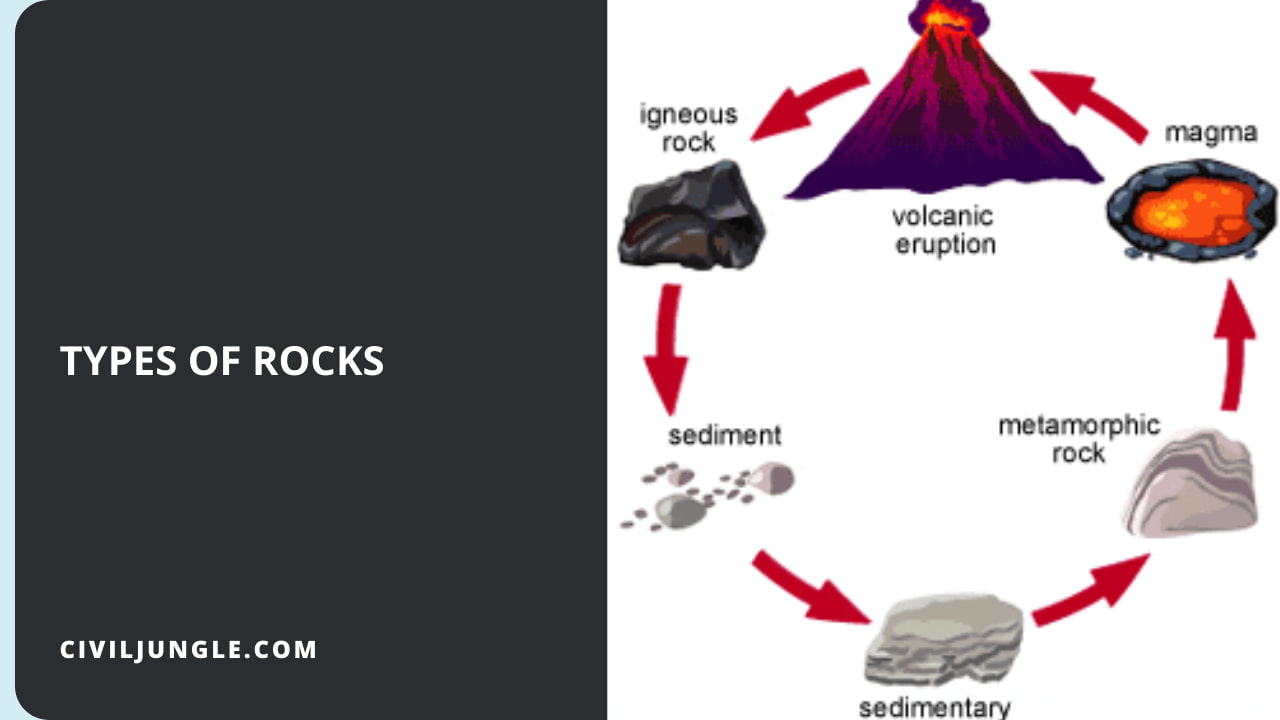
There are three main types of rocks:
- Igneous Rocks.
- Sedimentary Rocks.
- Metamorphic Rocks.
Type #1. Igneous Rocks.
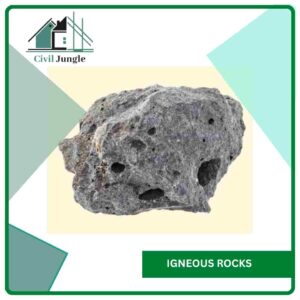
Igneous rock (derived from the Latin word ignis meaning fire), or magmatic rock, is one of the three main rock types, the others being sedimentary and metamorphic.
The Rock which is formed due to cooling down of Magma from the volcanoes is known as igneous rock. Magma is a liquid composition of molten minerals which usually form at the core of the earth.
Type #2. Sedimentary Rocks.
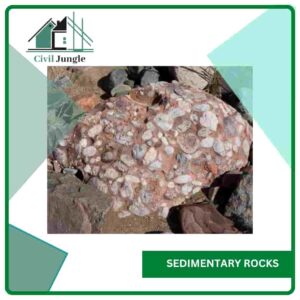
Sedimentary rocks are types of rock that are formed by the accumulation or deposition of mineral or organic particles at the earth’s surface, followed by cementation. Sedimentation is the collective name for processes that cause these particles to settle in place.
Type #3. Metamorphic Rocks.

Metamorphic rocks where once Stadium entry, as well as an igneous rock but they, changed to the Metamorphic rock due to extreme heat and pressure. Metamorphic rocks formed when the rocks are subjected to high heat and pressure.
Processes in the Rock Cycle

Several processes can turn one type of rock into another type of rock. The key processes of the rock cycle are as below:
- Crystallization Process.
- Sedimentation and Erosion Process.
- Metamorphism Process.
1. Crystallization Process.
In the crystallization process, the Magma gets cool on the surface or underground and get hardened which forms igneous rocks. When the Magma gets cool, there are various crystals which are formed at a different temperature undergoing the crystallization.
The rate of cooling will determine how much time the crystals will get to form. The process of cooling is slow in the crystals are produced of larger size.
2. Sedimentation and Erosion Process.
Weathering of the rock on the surface of the earth into the smaller pieces. The smaller pieces of fragments are known as sediment. These elements get transported from one place to another place by the running water, ice or gravity.
Then during the process of sedimentation in the sediments are laid down new to form the sedimentary rock. This sediment which gets accumulated must become compacted and cemented together.
3. Metamorphism Process.
Metamorphism is the process of change of the minerals or geological texture of the rocks. This change in the rock occurs due to extreme heat and pressure.
When the rocks get exposed to the extreme heat and pressure within the earth but it does not melt then the rocks get metamorphosed. Metamorphism changes the composition of the mineral and the texture of the rock.
What Are the Steps of the Rock Cycle?
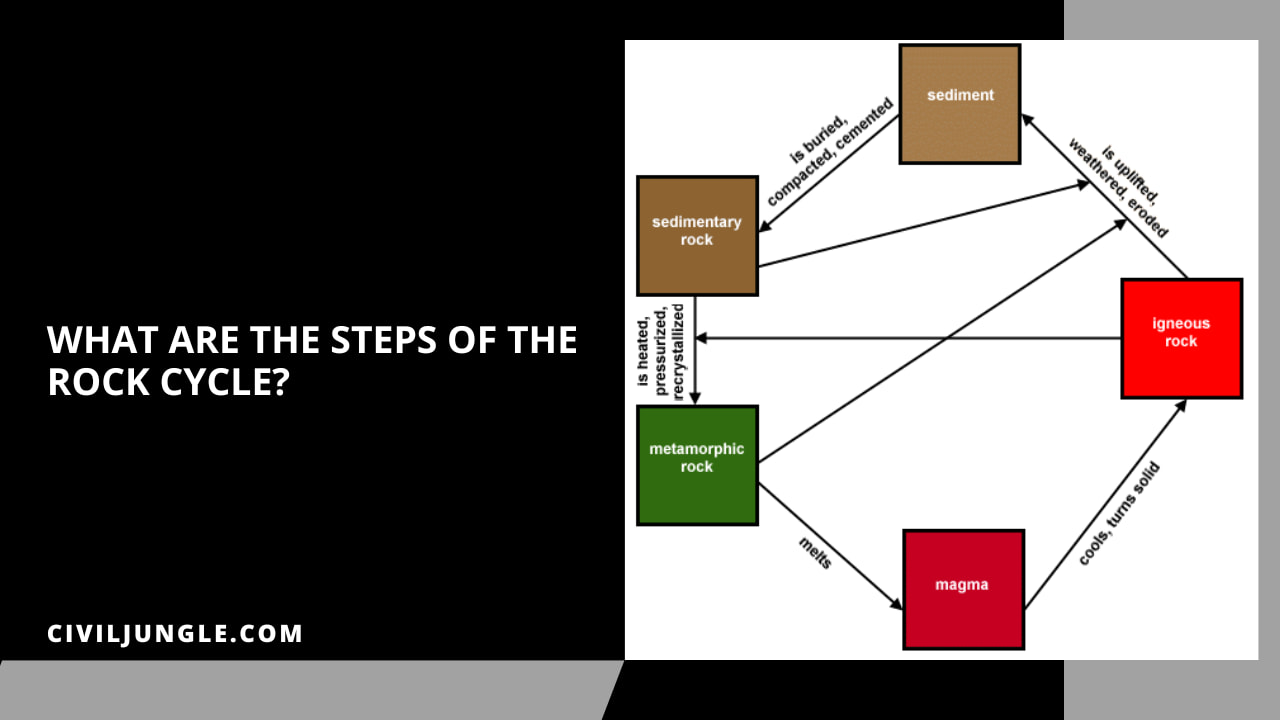
Rock cycles steps in order are as follows
- Weathering Process
- Chemical Process
- Physical
- Biological
- Erosion and Transport
- Deposition of the Sediment
- Burial and Compaction
- Crystallization of Magma
- Melting Process
- Defamation and Metamorphism
- Summary
1. Weathering Process.
Weathering is the process in which rock is broken down into smaller and smaller particles without any help of the transporting agents. The rocks get to break down into three types which are chemical, physical and biological agents.
2. Chemical Process.
Chemical weathering is caused by rain water reacting with the mineral grains in rocks to form new minerals (clays) and soluble salts. These reactions occur particularly when the water is slightly acidic.
3. Physical.
Physical weathering is caused by the effects of changing temperature on rocks, causing the rock to break apart. The process is sometimes assisted by water.
4. Biological.
Weathering is the breaking down or wearing away of rocks where they are. One type, biological weathering, is caused by animals and plants. For example, rabbits and other burrowing animals can burrow into a crack in a rock, making it bigger and splitting the rock.
5. Erosion and Transport.
Erosion is the process by which soil and rock particles are worn away and moved elsewhere by wind, water, or ice.
Transport refers to the cycle processes by which the sediment is moved along, for example, pebbles rolled along a river bed or sea shore, sand grains whipped up by the wind, salts carried in solution.
6. Deposition of the Sediment.
A deposition is when sediments, soil, or rocks are added to the land. It is the opposite of erosion. A deposition is a constructive process because it builds or creates landforms. Just as wind, water, and other forces can wear away sediments over time, sediments must also be deposited.
7. Burial and Compaction.
As layers are piled one upon another, the sediments beneath are buried, sometimes by hundreds of metres of sediment above.
The weight of these layers compacts (squashes down) the sediment grains. Minerals deposited from water in the spaces between the sediment grains gradually cement them together.
8. Crystallization of Magma.
Magma is basically the liquid which is a form of rocks under threat pressure and temperature due to heat. In this process, the Magma get cools on the surface of the underground and gets hardened to form igneous rock.
9. Melting Process.
Sedimentary rocks form by breaking down other kinds of rocks into small particles and washing or blowing them away; metamorphic rocks form other rocks and igneous rocks form by melting other rocks. Thus rocks are always changing form and are redistributed as part of a giant cycle of renewal.
10. Uplift.
Just like sedimentary rocks, metamorphic rocks can be forced to the Earth’s surface too. All this movement can cause rocks that were once underground to be brought up to the Earth’s surface.
This process is called uplift. Once exposed to the elements the rock on the Earth’s surface begins to weather and erode.
11. Deformation and Metamorphism.
The Earth’s crust is slowly moving. The huge forces that move continents stretch and squash parts of the Earth’s crust., generating earthquakes and building mountains.
They cause rocks near the surface to be fractured and faulted. At greater depth, the heat and pressure involved can cause folding and/or metamorphism.
12. Summary.
The three main rock types are igneous, metamorphic and sedimentary. The three processes that change one rock to another are crystallization, metamorphism, and erosion and sedimentation.
Any rock can transform into any other rock by passing through one or more of these processes. This creates the rock cycle.
Uses of Rocks in the Construction
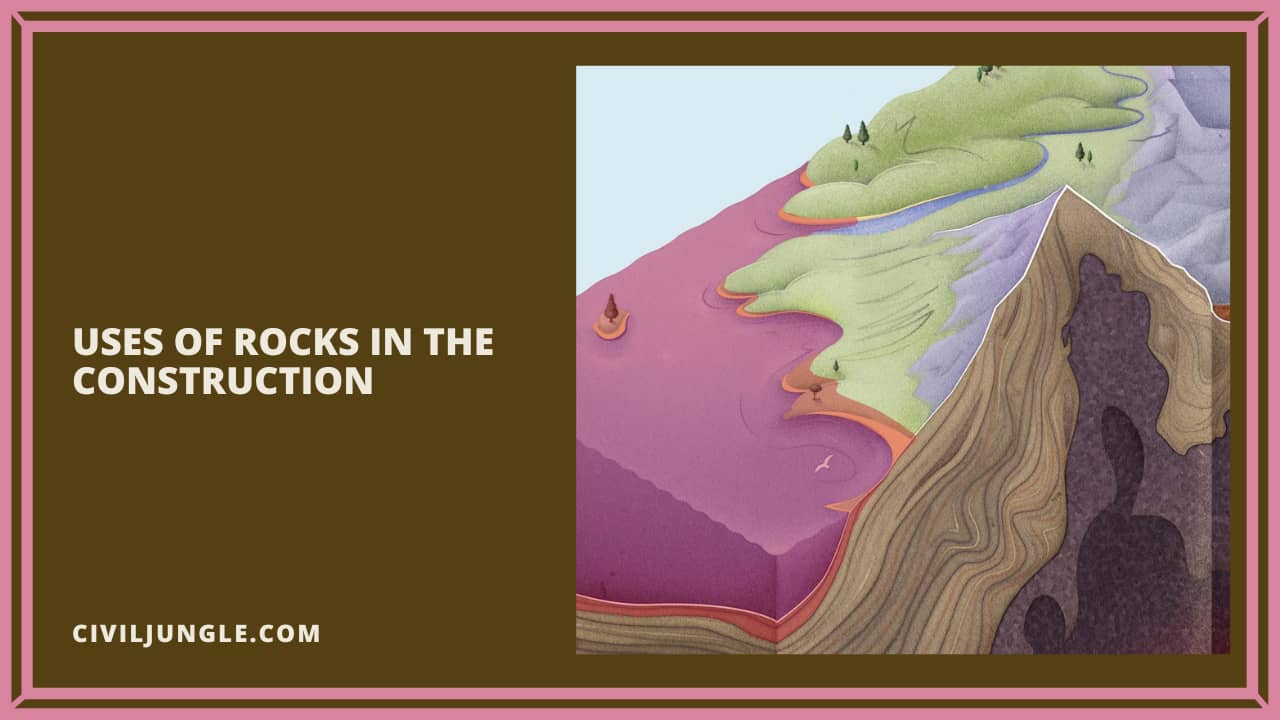
Rocks are widely used in the construction of buildings and highways
- Rocks are using for making bricks, fire places and kitchen counter of our homes, dams, buildings, railway ballast, pavement material, road metal, concrete aggregates etc.
- Rocks are extremely important in terms of their stability and strength as a geological material on which construction foundation is made.
- Blocks of stones are generally used in the construction of foundation, walls, Bridge, piers abutments, lighthouses and aqueducts etc.
- Rocks are used in the construction of masonry work, lintels and columns etc.
- Rocks are also used in the construction of retaining walls in the hilly areas.
- Broken or crushed rocks are widely used as ballast in the construction of railway tracks.
- Rocks are also used in the construction of slabs which are used for paving or roofing.
- Nowadays stone screenings are also used as a substitute for the sand.
- Rocks in the crushed form used as aggregate in concrete.
FAQs on the Rock Cycle
What Is the Rock Cycle?
The rock cycle is a natural process that describes the transformation of rocks between three main types: igneous, sedimentary, and metamorphic. These transformations occur due to various geological processes such as melting, cooling, erosion, and pressure.
What Are the Three Main Types of Rocks in the Rock Cycle?
The three main types of rocks in the rock cycle are igneous, sedimentary, and metamorphic rocks.
How Is Igneous Rock Formed?
Igneous rock is formed from the cooling and solidification of magma or lava. When magma cools slowly beneath the Earth’s surface, it forms intrusive igneous rocks. When it cools rapidly on the surface, it forms extrusive igneous rocks.
What Is Sedimentary Rock, and How Does It Form?
Sedimentary rock is formed by the accumulation and compaction of mineral and organic particles, often in bodies of water. Over time, these sediments are cemented together to form sedimentary rocks.
What Processes Lead to the Formation of Metamorphic Rock?
Metamorphic rock forms when existing rocks are subjected to extreme heat and pressure, causing them to undergo physical and chemical changes. This process, known as metamorphism, alters the mineral composition and structure of the rock.
How Does Weathering Contribute to the Rock Cycle?
Weathering breaks down rocks into smaller particles through physical, chemical, or biological processes. These particles can then be transported and deposited to form sedimentary rocks, continuing the rock cycle.
What Is the Role of Erosion in the Rock Cycle?
Erosion involves the movement of rock particles from one location to another by wind, water, or ice. This transportation plays a critical role in shaping landscapes and forming sedimentary rocks.
What Is Crystallization in the Rock Cycle?
Crystallization is the process by which magma cools and solidifies to form igneous rocks. The rate of cooling affects the size of the crystals that form, with slower cooling leading to larger crystals.
How Do Rocks Return to the Surface After Being Buried Deep Within the Earth?
Uplift is the process that brings rocks buried deep within the Earth back to the surface. This can occur due to tectonic forces that push the Earth’s crust upward.
Why Are Rocks Important in Construction?
Rocks are essential in construction due to their stability, strength, and durability. They are used in foundations, walls, bridges, roads, and many other structures. Different types of rocks, such as granite, limestone, and sandstone, have specific properties that make them suitable for various construction applications.
Can Any Type of Rock Become Another Type Through the Rock Cycle?
Yes, any type of rock can transform into another type through the processes of the rock cycle. For example, igneous rock can become sedimentary rock through weathering and erosion, or metamorphic rock through heat and pressure.
How Long Does It Take for Rocks to Change Types in the Rock Cycle?
The rock cycle operates over millions of years. The processes involved, such as erosion, sedimentation, and metamorphism, occur very slowly over geological time scales.

